



China's Food Self-sufficiency Policy
It is unlikely China will be able to maintain self-sufficiency on all major agrifood commodities, according to Matthew Hyde and Faraz Syed in the latest Agricultural Commodities quarterly report from the Australian Bureau of Agricultural and Resource Economics and Sciences (ABARES). Rice, wheat and pig meat are likely to remain the focus of China’s self-sufficiency policy but resource constraints will challenge its ability to maintain self-sufficiency in beef, sheep meat, soybeans and feed grains.China’s agricultural sector is supported by a number of policies that are collectively designed to achieve a food self-sufficiency objective. The objective stems from the Chinese Government’s view that China’s food security is best maintained by meeting its domestic food demand with domestically produced food and minimising its reliance on international markets.
While food imports have increased significantly over the past decade, in general they remain only a small proportion of domestic consumption in China. This box provides an overview of some policies implemented in China that support food self-sufficiency. It analyses recent growth in imports of food to highlight how changes in trade might affect the self-sufficiency objective.
Under the food self-sufficiency objective the Chinese Government has a self-sufficiency target for a number of crops. The target aims to satisfy a minimum of 95 per cent of domestic consumption of rice, wheat, coarse grains, soybeans and potatoes through domestic production. While the target explicitly focuses only on these crops, production of other foods is generally supported by a range of other policies (Simon et al. 2014).
The 95 per cent self-sufficiency target on the specified crops, with the exception of soybeans, has largely been achieved since its establishment in 1996. China’s soybean imports grew significantly between 1996 and 2013 and in 2013 supplied 80 per cent of total domestic consumption. As a result, it appears that the Chinese Government deleted soybeans from its self-sufficiency target in late 2013, allowing the aggregate 95 per cent target to be attained for the remaining crops (Pumin 2013).
China’s self-sufficiency objective is especially important for international trade of staple foods, such as rice and pig meat. The international markets for these commodities are relatively thin and any significant change in Chinese import demand can create strong volatility in world prices. For example, China’s pig meat imports were close to eight per cent of global trade in pig meat in 2012, but this was less than one per cent of its domestic consumption (OECD–FAO 2013).
Since 2009 China’s imports of many food commodities (including targeted crops such as wheat and corn) have increased. This has fuelled speculation that the self-sufficiency objective may be relaxed for some commodities or even abolished in the future (China Economic Review 2014). Coupled with this speculation are concerns about China’s ability to maintain self-sufficiency given production constraints facing its agricultural sector and the pace at which domestic demand for food is increasing. For example, land and water quality have become progressively degraded, challenging the agricultural sector to provide for a growing and increasingly affluent population.
For cereal crops, such as wheat and rice, ABARES projects that demand growth between 2009 and 2050 will outpace production growth. The real value of Chinese cereals consumption is projected to increase by 52 per cent over that period, while the real value of domestic production of cereals is projected to rise by only 29 per cent (Hamshere et al. 2014).
China’s Policies on Food
The self-sufficiency objective is one of the main reasons the Chinese Government intervenes in agricultural markets. Self-sufficiency is supported by domestic policies that encourage increased agricultural production, such as market price support, agricultural subsidies and rural land reforms. China’s trade policies also allow the government to maintain control over the import and export of important food products, such as rice and wheat.
China’s self-sufficiency policies tend to focus on grains, oilseeds and potatoes because of their direct or indirect importance to Chinese consumers. While wheat, rice and potatoes are directly consumed as food, corn and soybeans are mostly used as feed for the intensive livestock industries. The inclusion of corn and soybeans in the self-sufficiency target relates to their role as inputs to pig and poultry meat production, because of the importance of these meats to Chinese diets. Although soybeans are also consumed as food, their use as food constitutes only around 12 per cent of total soybean consumption in China.
Market price support
The primary tool used to encourage production of the targeted crops is a minimum purchase price in major producing regions. This policy has applied to rice and wheat since 2006 and was widened to include soybeans, canola and corn in 2008 (Gale 2013). Under this policy, producers are guaranteed a minimum price for their product. The price is set by the Chinese Government and maintained through purchases by state trading enterprises (STEs). The minimum prices have been increased each year since 2009 to protect producers from rising input costs and the appreciation of the yuan (OECD 2013).
China also operates a grain reserve system, where non-producing provinces are required to stockpile a minimum amount of wheat and rice as a means of controlling price volatility and ensuring supply. This programme was initially designed for rice and wheat but is also used for storage of corn and canola; until 2014 it was also used for soybeans. These reserves are released through an auction system as the availability of grains and oilseeds in the domestic market declines following harvest (Gale 2013).
Since provincial reserves reportedly account for up to six months of consumption, the grain reserve programme allows the government to cover a shortfall or disruption to domestic production in the short term (OECD 2013). The programme reduces the need for imports.
A pig meat reserve programme in place since 2009 manages price volatility in the domestic pig meat market by controlling supply. Under this policy, government interventions in the pig meat market are based on movements in the pig meat-to-corn price ratio. The Chinese Government subsidises pig meat processors to stockpile frozen pig meat if its price is less than five times the price of corn. These stocks are released into the market only when the price of pig meat rises above nine times that of corn (Rabobank 2012). By managing the supply of pig meat on the domestic market, the Chinese Government constrains price fluctuations and is able to maintain incentives for pig meat production in spite of rising feed costs.
Agricultural modernisation and rural reform
The Chinese Government’s stated modernisation policies aim to improve uptake of modern agricultural practices and commercial farming. These policies support the self-sufficiency objective by targeting both increased domestic food production and reduced production variability. Given that arable land in China is limited, and use of fertilisers and other inputs is high, productivity gains are necessary to increase production and meet future expected higher demand for food (Hamshere et al. 2014).
Modern production systems, including increased mechanisation in grain production and larger farms, are considered the main sources of future agricultural productivity growth in China (World Bank 2014).
Many of China’s modernisation policies are based on subsidies for the purchase of inputs, such as tractors and improved seed varieties, and for encouraging modern practices such as improved livestock breeding (OECD 2013). The subsidies are designed to provide farmers with incentives to replace traditional labour-intensive and low-productivity methods of farming with modern production systems, which will increase production, decrease labour requirements and reduce production variability. Other subsidies, known as awards, are paid directly to county governments in areas that have high grain or pig meat production. These subsidies are aimed at encouraging public investment in both infrastructure and research to support production (Gale 2013).
Since 2004 the Chinese Government has implemented rural land reforms to, among other objectives, encourage the development of larger farms. These aim to improve the productivity of extensive cropping operations for the targeted crops, thereby supporting the self-sufficiency target. The average farm size in China is around 0.6 hectares, so productivity can be improved through economies of scale (FAO 2012).
Because many producers work on land rented from village collectives, access to credit is limited. Producers’ ability to invest in expanded operations and modern equipment is constrained as a result. Changes to the land reform agenda announced in January 2014 are expected to strengthen the contractual rights of producers over rented farmland, allowing producers to use land to secure loans and simplifying land transfers to create larger enterprises (China Daily 2014).
Agricultural trade policy
China’s trade policy allows the government to maintain some control over the trade of agricultural products through the market operations of STEs and trade restrictions. Imports of agricultural products are restricted through either tariff rate quotas (TRQs) or import tariffs. Overall, China’s most-favoured nation applied tariffs on agricultural products average 14.8 per cent, compared with 8.6 per cent for non-agricultural products (WTO 2014). For target grains, such as wheat, rice and corn, imports are subject to a TRQ with an applied in-quota rate of just one per cent and quotas equivalent to between two and eight per cent of 2012 domestic production.
A prohibitive out-of-quota tariff of 65 per cent is applied to imports of each of these grains. This effectively limits imports at the quota levels, thereby supporting the self-sufficiency target for these grains. Tariff reductions for target grains have not been included in any of China’s recently negotiated free trade agreements, including those with Australia, Pakistan and New Zealand.
China maintains state trading to ensure stable supply and prices of important agricultural products and to safeguard its food security (WTO 2014). STEs have exclusive access under the TRQs to import wheat, rice and corn. The share of the imported volume allocated to the state traders is as high as 90 per cent for wheat.
The STEs may allow imports to make up for a domestic shortfall or to build up public stockpiles. They can also restrict low-priced imports of products that threaten to put downward pressure on domestic producer prices. If low-priced imports enter the domestic market, they would have to make minimum price purchases of domestic product to support the domestic producer price, with those purchases going into stocks. STEs can also restrict exports through export quotas to ensure domestic availability.
Recent Trends in Chinese Agrifood Imports
Since 2004 China’s imports of agrifood products (all agricultural output that can be used for food) have grown significantly. The real value of China’s imports of agrifood products increased by 275 per cent between 2004 and 2013, to US$99 billion (in 2013 US dollars). The fastest growing categories were dairy products (up by 847 per cent), fruit and vegetables (427 per cent), oils and oilseeds (254 per cent), meat and seafood (209 per cent) and cereals (84 per cent).
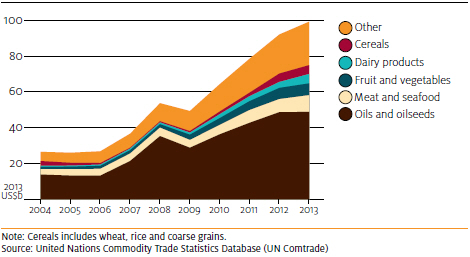
The most rapid import growth occurred between 2009 and 2013, when the real value of China’s agrifood imports doubled. Changing diets and increasing incomes of Chinese consumers have led to an increase in not only the quantity but also the quality and diversity of food demanded (Hamshere et al. 2014). With consumption growth exceeding production growth for a range of commodities over this period, domestic prices have risen. Increased openness to trade by the Chinese Government through free trade agreements has allowed imported products to satisfy demand. As a result, imports of fruit, vegetables, meat, dairy products and seafood have increased significantly.
Demand for imported feed grains and oilseeds has also increased as domestic livestock production has expanded in response to stronger demand for meat.
While the self-sufficiency ratio for the targeted crops has remained above 95 per cent since 2009 (with the exception of soybeans), continued high domestic prices could challenge Chinese self-sufficiency in these crops in the future.
Cereals and oilseeds
China’s imports of wheat, rice and corn have all increased over the past five years despite record domestic production. While China had imported these grains sporadically in the past, it was a net exporter of all three before 2007. By 2012 it was a net importer of all three grains.
Soybeans are the main oilseed imported into China. Since 2004 imports of soybeans have grown significantly, while domestic production has declined. In 2013 imports of soybeans totalled US$38 billion, or around 42 per cent of total agrifood imports by value.
Rice is a staple food in the Chinese diet. Although rice imports account for a small proportion of domestic consumption (around 2 per cent a year), China imported 3.4 million tonnes of rice in 2013. Vietnam was the largest supplier to China in that year, accounting for 59 per cent of rice imports, followed by Thailand (22 per cent).
Over the past five years, the United States has supplied a significant share of China’s imports of corn, wheat and soybeans. In 2013 the United States supplied 90 per cent of China’s corn imports, 68 per cent of wheat imports and 35 per cent of soybean imports. However, in October 2013 China prohibited imports of MIR162 corn, a genetically-modified variety that is widely used in the United States. As a result, between January and August 2014, exports of US corn to China were around 86 per cent lower than for the same period in 2013. China made up for the shortfall through domestic production and increased imports from Ukraine.
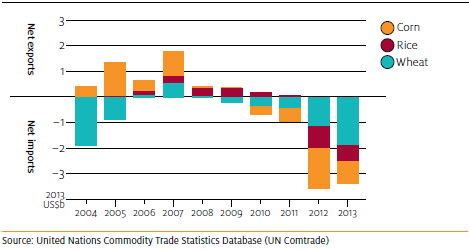
Grain imports have risen since 2009 because of rising domestic demand and the resulting increase in domestic prices. Domestic prices have also risen in response to increases in support prices (Gale 2013). For those crops that undergo additional processing or are used as feed (such as rice, corn and soybeans), imported product is often the lowest cost option. As inputs to further processing, lower-priced imports allow processors to retain their margins.
For rice and wheat, the recent growth in imports is unlikely to be maintained over the long term given the role of state trading in these commodities. Wheat imported over the past two years has principally been a high-quality product for blending with domestic grain for milling (Price 2014). In 2011 domestic prices for wheat were higher than the support price, so the STEs made no domestic wheat purchases at the support price. This may have contributed to the rise in imported wheat in 2012 and 2013 to support the reserve system (USDA–FAS 2014). This is comparable to 2004, when China imported a significant volume of wheat to replenish its domestic stockpiles, but this did not lead to a long-term increase in wheat imports.
For corn and soybeans, import growth is likely to continue as long as domestic feed prices remain high. Increased demand for meat and livestock products, combined with rising support prices, have put upward pressure on domestic feed grain prices despite record corn production. Because land remains limited, any further rise in production of corn and soybeans remains unlikely without either a reduction in the area planted to wheat and rice (grains for which relative returns exceed those of corn and soybeans because of higher support prices) or substantial productivity gains.
Despite the increase in grain and oilseed imports, the volume of imports relative to domestic consumption remains small for rice, wheat and corn. In 2013–14 China’s self-sufficiency ratios were around 99 per cent for corn, 98 per cent for rice and 97 per cent for wheat. In contrast, the self-sufficiency ratio for soybeans was around 26 per cent.
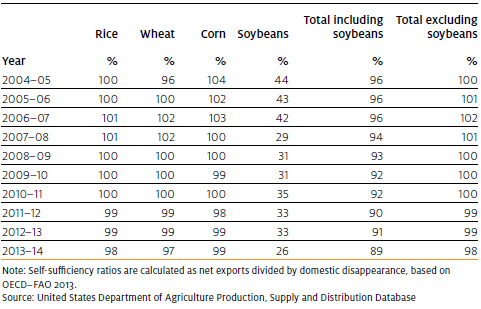
Meat and dairy products
The value of China’s imports of meat and dairy products increased almost 10-fold between 2004 and 2013 (in 2013 US dollars). This was driven by large increases in China’s imports of beef, sheep meat and dairy products. Production during this period grew slightly but was well below the rate of consumption.
In 2013 Australia supplied most of China’s beef imports by value (57 per cent), and it was the second-largest supplier of sheep meat (39 per cent). New Zealand supplied most of China’s imports of sheep meat (57 per cent) and dairy products (63 per cent). The major suppliers of pig meat were the United States (21 per cent) and Germany (19 per cent). Poultry imports were sourced mainly from Brazil (48 per cent) and the United States (42 per cent).
Meat and livestock products are not supported to the same extent as grains and oilseeds, and different factors have contributed to import growth. While the traditional source of protein in China is pig meat, income growth and urbanisation have contributed to increased demand for meat and dairy products. Food safety concerns, such as those highlighted by the melamine in baby formula scandal, have also contributed to increased consumer preference for imports.
Another important factor influencing the rise in meat imports is high domestic production costs. As the support prices of soybeans and corn have been increased, livestock producers have faced higher feed costs. Dairy supply has been affected by consumer concerns over food safety, which led to additional regulations being imposed on dairy producers and forced many small producers to exit the industry. Resulting higher prices for meat and dairy products have driven demand for imported products.
China’s meat imports remain small relative to domestic consumption and it has maintained a high level of self-sufficiency in these products. However, self-sufficiency rates for beef and dairy products have been trending downwards over the past two years, as imports have increased significantly. Without considerable productivity growth in these industries, imports are likely to continue to grow.
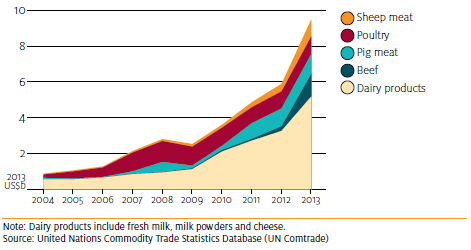
Future of China’s self-sufficiency
China’s self-sufficiency objective is likely to be challenged in the future. Increasing demand for a wider variety of food products will put pressure on the land and water resources required for agricultural production. The policy response to these factors will determine whether China is able to maintain self-sufficiency in the long term.
China’s comparative advantage in agricultural production is in labour-intensive products, such as horticulture and intensive livestock production, rather than extensive cropping. This is because of relatively low rural labour costs and land constraints stemming from the ongoing conversion of arable land to urban development. The result is that products China views as most important, such as rice and wheat, are not those that it can produce most efficiently. Returns to producers for these products are, in the absence of support prices, relatively low.
As China becomes increasingly urbanised, demand for meat is projected to increase while demand for staple grains (such as rice) is projected to decrease (Hamshere et al. 2014). Higher meat demand will necessitate more imports of either meat for consumption or feed grains to support intensive livestock production. Because of the importance of pig meat to the Chinese diet, and a consumer preference for fresh over frozen product, it is unlikely that China would prioritise imports of pig meat (Rabobank 2012).
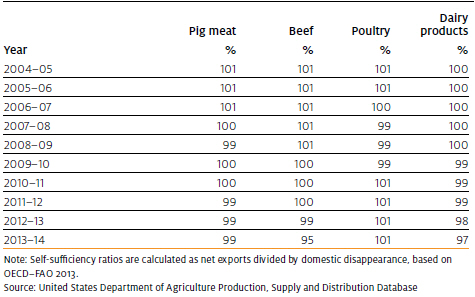
Recent policy changes have attempted to reduce both food inflation and imports. Support prices for corn and wheat were not increased in 2014-15, after having been increased each year since 2008-09. A pilot target price mechanism was also proposed in early 2014 to replace minimum price purchases for soybeans in key provinces.
To maintain producer support, the government will instead pay subsidies to producers if the domestic price falls below the set target, which will allow the domestic price to align with the world price. For soybeans, this policy is likely to reduce the domestic price. This will make domestic supplies more appealing to processors and reduce incentive to import.
It is unlikely China will be able to maintain self-sufficiency on all major agrifood commodities. Recent experience has shown that productivity growth in the target crops has not raised production enough to satisfy demand growth. Rice, wheat and pig meat are likely to remain the focus of China’s self-sufficiency policy but resource constraints will challenge its ability to maintain self-sufficiency – especially for products like beef, sheep meat, soybeans and feed grains. Therefore, rising import trends are likely to continue.
References
- China Daily. 2014. Back up rural land reform. China Daily, 23 January.
- China Economic Review. 2014. Has China really ditched its grain self-sufficiency policy? China Economic Review, 19 February.
- FAO. 2012. Agriculture and trade policy background note: People’s Republic of China. Food and Agriculture Organization of the United Nations, Rome.
- Gale, F. 2013. Growth and evolution in China’s agricultural support policies. United States Department of Agriculture Economic Research Service, Washington DC.
- Hamshere, P., Sheng, Y., Moir, B., Syed, F. and Gunning-Trant, C. 2014. What China wants: analysis of China’s food demand to 2050. Paper presented at 44th ABARES Outlook conference, Canberra, 4–5 March (pdf 1.2mb).
- OECD. 2013. China. In 'Agricultural policy monitoring and evaluation 2013'. Organisation for Economic Co-operation and Development, Paris.
- OECD–FAO. 2013. Feeding China: prospects and challenges in the next decade. In OECD–FAO 'Agricultural outlook 2013'. Organisation for Economic Co-operation and Development and Food and Agriculture Organization of the United Nations, Paris.
- Price, C. 2014. Wheat. In 'Agricultural commodities: June quarter 2014'. Australian Bureau of Agricultural and Resource Economics and Sciences, Canberra.
- Pumin, Y. 2013. Feeding the future: new challenges in ensuring food security require new solutions. Beijing Review. 2 January.
- Rabobank. 2012. Industrialisation of China’s pork supply chain., Rabobank. Netherlands, September. (pdf 503kb).
- Simon, K., O’Conor, G., Christopher M. and Brown, M. 2014. Facing grain shortfalls, China asserts self-sufficiency policy. China Brief, vol.14, no.7.
- USDA-FAS. 2014., China, Peoples Republic of — grain and feed annual. GAIN Report, no.14016, 2 April, Foreign Agricultural Service, United States Department of Agriculture, Washington DC. (pdf 869kb).
- World Bank. 2014. China economic update. June, Beijing, available at worldbank.org/en/country/china/publication/china-economic-update-june-2014.
- WTO. 2014. Trade policy review: China. World Trade Organization, Geneva.
December 2014








